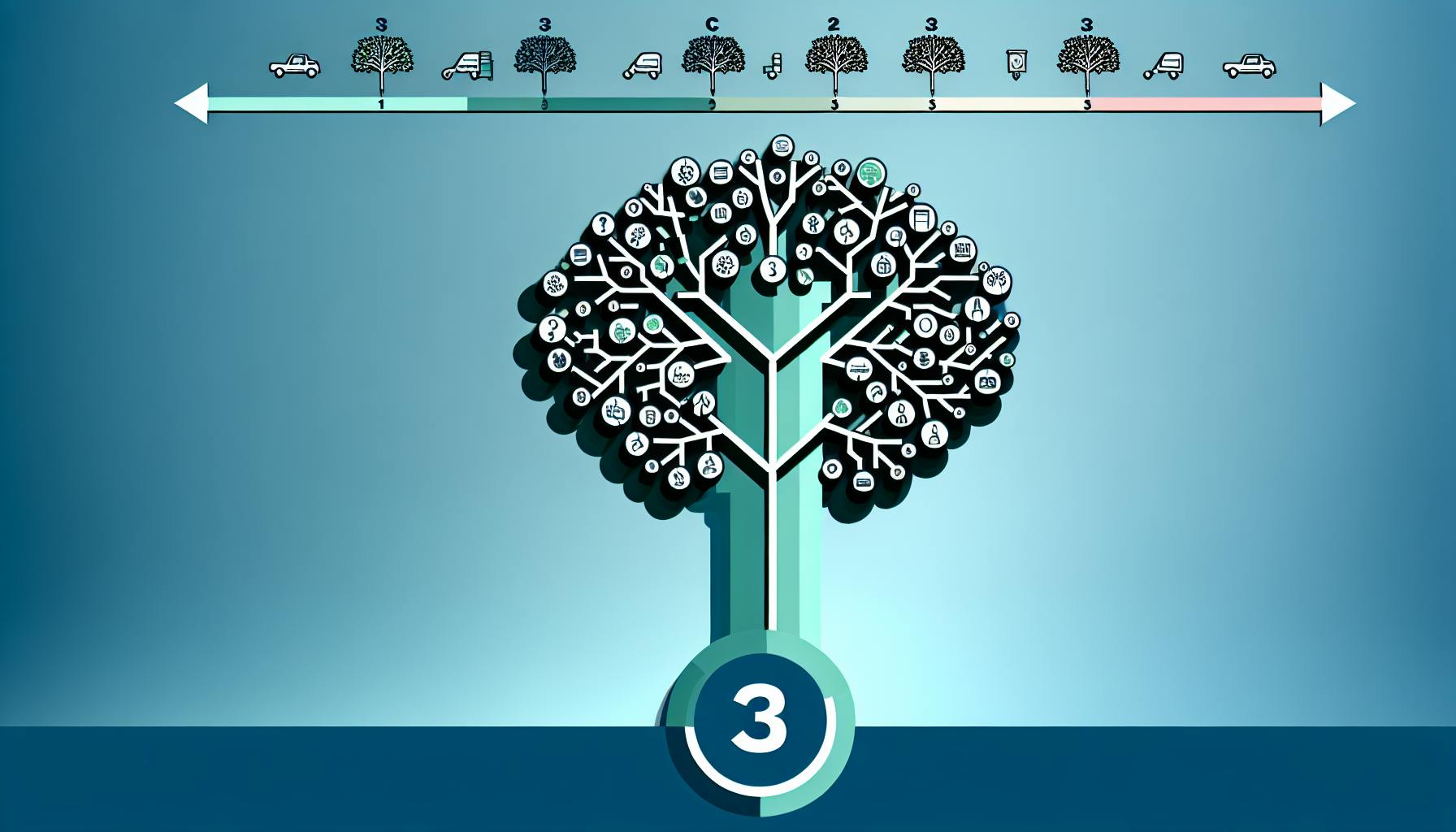Calculating scope 3 emissions can seem incredibly complex for businesses without deep sustainability expertise.
However, by breaking down the process into straightforward steps around data collection, methodologies, and reporting, businesses can develop a simplified approach to understanding and responsibly managing scope 3 emissions.
In this guide, we will demystify the scope 3 calculation process for SMEs through illustrative examples, Excel templates for data organization, choosing accurate emissions factors, and tips for transparent reporting and verification.
Unpacking the Complexities of Calculating Scope 3 Emissions
Defining Scope 3 Emissions
Scope 3 emissions refer to indirect greenhouse gas emissions across a company's entire value chain. While scope 1 covers direct emissions from owned or controlled sources and scope 2 accounts for indirect emissions from purchased electricity/steam/cooling, scope 3 encompasses all other indirect emissions not included in scope 2. This includes activities like procurement of goods and services, transportation and distribution, business travel, employee commuting, investments, leased assets, waste disposal, and product use and end-of-life treatment. With complex global supply chains, scope 3 often makes up the majority of an organization's total emissions.
The Significance of Tracking Scope 3 Emissions
As stakeholder demands and regulations on environmental disclosures increase, measuring and reporting scope 3 emissions is becoming critically important for companies of all sizes. Getting ahead of impending mandatory requirements can also unlock new opportunities for efficiency, innovation, and strategic advantage. While calculating scope 3 can be complicated, failing to account for and reduce these indirect emissions undermines net-zero commitments. Approaching this process systematically and leveraging automated solutions can help streamline scope 3 management.
How is Scope 3 emissions calculated?
Calculating Scope 3 emissions can seem daunting, but breaking down the process helps simplify it. The key steps are:
Obtain activity data
- Collect data on the goods and services your company purchases. This includes procurement records detailing transaction volumes and spend.
Identify emissions factors
- Emissions factors provide standardized CO2e emissions per unit of activity. Sources like government databases and industry associations provide factors for different goods and services.
Calculate emissions
- Multiply the activity data by the matching emissions factor to estimate emissions. For example, kWh of electricity purchased x electric emissions factor = CO2e emissions.
Address uncertainties
- Scope 3 calculations can have variability and gaps. Disclose your methodologies, activity boundaries, and any exclusions.
Track performance
- Update the calculations annually to monitor emissions over time and gauge reduction progress. Refine data quality and methods progressively.
The main complexity lies in collecting comprehensive procurement data and matching suitable emissions factors. But by systematically working through the key steps, businesses can produce meaningful scope 3 calculations. Consult expert guidance documents for additional technical instructions tailored to your reporting needs.
How do you solve Scope 3 emissions?
Reducing Scope 3 emissions can seem daunting, but taking small, consistent actions to engage suppliers, employees, and even customers can make a major difference over time. Here are four practical steps companies can take:
Collect Supplier Emissions Data
The first key step is to measure your supply chain emissions by requesting emissions data from major suppliers. This allows you to identify hotspots and prioritize engagement efforts. Start the conversation by explaining why you need this data and offering resources or training to aid their reporting process if needed.
Offer Sustainability Support
Next, provide training, templates, financing, or other tools to help engaged suppliers actively reduce their operations emissions year-over-year. Encourage goal-setting while recognizing even small actions. Publicly showcase sustainability leaders.
Incentivize Sustainable Commuting
With transportation being a major contributor to emissions, offer benefits for employees using public transit, rideshares, biking, or EV charging. Consider subsidizing sustainable alternatives to driving alone. Recognize teams making the effort.
Design For Circularity
Finally, continually seek ways to design products and packaging - and influence customers - to enable reuse, refurbishment, and recycling. Support right-to-repair legislation. Consider takeback programs. Innovate systems, not just products.
Small, consistent effort in these areas can drive significant collective change over time by activating stakeholders across the value chain. The key is to start now, learn continuously, and improve collaboration for shared progress.
What is the most accurate method to measure Scope 3 emissions?
The most accurate method to measure scope 3 emissions is through supplier-based (primary) data. This involves directly tracking the emissions from your individual suppliers, and using that data to estimate the emissions associated with the goods and services you purchase.
Some key things to know about using supplier-based data:
- It provides the most precise carbon accounting, since you are using real emissions data from your suppliers rather than estimates. This allows you to reliably report and track scope 3 over time.
- Collecting quality supplier data can be very time and resource intensive. You need processes in place to systematically gather supplier emission reports on an ongoing basis.
- Small and medium-sized enterprises often have leverage challenges getting supplier participation, so partnering with larger customers can help persuade suppliers to share data.
- Scope 3 reporting using supplier data is still an evolving capability. Methodologies are still being improved to capture emissions accurately across the many scope 3 categories.
- Privacy issues around sharing supplier data is still a barrier. Developing industry-wide protocols to anonymize data can help ease data access.
In summary, supplier-based accounting delivers superior accuracy but involves significant effort. Leveraging industry groups, partnerships and emerging solutions can help SMEs overcome barriers to access primary data for rigorous scope 3 emissions measurement.
What is an example of a scope 3 emissions?
Scope 3 emissions refer to the indirect greenhouse gas emissions from a company's value chain. Some examples of scope 3 emissions categories include:
- Purchased goods and services: Emissions from the extraction, production, and transportation of goods and services purchased by the company
- Capital goods: Emissions from the production of capital goods like equipment, facilities, and machinery purchased or acquired by the company
- Fuel- and energy-related activities: Emissions from the extraction, production, and transportation of fuels and energy purchased and consumed by the company
- Transportation and distribution: Emissions from the transportation and distribution of products sold by the company between the company and the end consumer
- Waste generated in operations: Emissions from the disposal and treatment of waste generated from the company's operations
- Business travel: Emissions from the transportation of employees for business-related activities
So in summary, scope 3 emissions are all the indirect emissions that occur across a company's entire value chain from the use of their products and the purchase of goods and services. Tracking scope 3 emissions provides companies a more complete view of their carbon footprint.
sbb-itb-919600f
Scope 3 Emissions Categories: Understanding Your Emissions Landscape
Scope 3 emissions refer to indirect greenhouse gas emissions that occur across a company's value chain. Understanding the categories of scope 3 emissions is an important first step for businesses looking to calculate and reduce their carbon footprint.
The 15 Categories of Scope 3 Emissions
The Greenhouse Gas Protocol defines 15 categories of scope 3 emissions that companies need to account for:
- Purchased Goods and Services
- Capital Goods
- Fuel and Energy-Related Activities
- Upstream Transportation and Distribution
- Waste Generated in Operations
- Business Travel
- Employee Commuting
- Upstream Leased Assets
- Downstream Transportation and Distribution
- Processing of Sold Products
- Use of Sold Products
- End-of-Life Treatment of Sold Products
- Downstream Leased Assets
- Franchises
- Investments
These categories cover emissions from a company's entire value chain, from the production of purchased materials to the end-of-life treatment of sold products.
For SMEs just starting the scope 3 accounting process, categories 1-3 often represent the largest share of emissions and are a good place to focus calculations initially.
Scope 3 Emissions Examples in Real-World Business Operations
Here are some examples of scope 3 emissions tied to common business activities:
- Materials purchased to manufacture goods fit under Category 1. The emissions from producing those materials are the company's scope 3 emissions.
- Business travel emissions, including flights, hotel stays, and rental cars, fall under Category 6.
- Emissions from external warehouses or distribution centers count as upstream or downstream transportation emissions based on their place in the value chain (Category 4 or 9).
- Employee commutes to and from the office contribute to scope 3 emissions (Category 7).
- Scope 3 emissions also come from the use of products sold. For example, emissions from customers driving gasoline vehicles sold by an automotive company are calculated under Category 11.
Understanding specifics like these helps SMEs identify the most material emissions to prioritize in their scope 3 calculations.
Data Collection for Scope 3 Emissions: Starting Your Calculations
Accurately calculating scope 3 emissions requires collecting relevant activity data from across your value chain. This includes information on operations involving third-party suppliers, distribution networks, investments, transportation providers, and other indirect activities.
Identifying Relevant Activity Data for Scope 3
Key data needed to calculate scope 3 emissions includes:
- Spend data from accounting systems, showing amounts purchased per supplier or service category
- Details on shipping and logistics from third-party transportation providers
- Information on business travel booked through travel agencies
- Waste output data from waste management partners
This data provides the activity amounts, such as kWh of electricity used or tonnes of waste generated, which can then be converted into emissions using appropriate emissions factors and global warming potentials.
For example, units of electricity purchased can be converted into emissions using a country or region-specific carbon emissions factor for grid electricity. Similar emissions factors exist covering other activity data like materials, transportation fuel, heat, and steam.
Gathering and Organizing Data with a Calculating Scope 3 Emissions Excel Template
Using a scope 3 emissions calculator Excel template can help SMEs easily gather, organize, and process all the relevant activity data needed. Key features of a useful Excel emissions calculator include:
- Pre-populated emissions factors covering various geographies and activities
- Automatic emissions calculations based on input activity data
- Charts showing emissions breakdowns by scope 3 category
- Ability to upload data from other sources via CSV
With the right Excel template, SMEs can avoid manual data entry and manipulation. The template handles emissions conversions automatically based on the latest emissions factors from reliable sources like UK DEFRA, US EPA, and IPCC.
This simplifies scope 3 calculations, ensures accuracy, and allows focusing resources on collecting robust activity data from across the value chain.
Calculating Scope 3 Emissions: Methodologies and Techniques
Technical Guidance for Calculating Scope 3 Emissions
There are various methodologies outlined in the GHG Protocol Scope 3 Standard for calculating scope 3 emissions. The method selected will depend on the availability of activity data and sector-specific calculation tools and models. Some common methodologies include:
- Spend-based: Calculating emissions from procurement spend using secondary emission factors and economic input-output data. Useful when detailed supplier data is unavailable.
- Fuel or material-based: Collecting activity data on quantities of fuels, materials or other resources consumed and applying appropriate emission factors.
- Transportation/logistics-based: Apportioning activity data such as weight, volume or distance shipped by transportation mode and using mode-specific emission factors.
- Modeling: Using proprietary or public models that combine various data inputs and calculations to estimate emissions for a specific industry or process.
SMEs should follow the principles of relevance, accuracy, completeness and consistency when collecting activity data. Primary data is most accurate, while secondary data from industry averages can serve as a proxy when unavailable.
Illustrating Calculations with a Scope 3 Emissions Example
Let's take an example of a fictitious manufacturing SME called ABC Manufacturing that produces industrial equipment.
To calculate emissions from purchased goods and services (Category 1), ABC collects spend data on raw materials purchased this year:
- Steel tubing: $120,000
- Electronics components: $30,000
- Other metals: $50,000
Since ABC does not have detailed emissions data from its suppliers, it utilizes secondary spend-based emission factors for the relevant material categories from a reliable database source:
- Steel tubing: 2.2 tCO2e/$1000
- Electronics: 1.3 tCO2e/$1000
- Other metals: 1.7 tCO2e/$1000
So ABC's Category 1 emissions are calculated as:
- Steel tubing spend x emission factor
- $120,000/$1000 x 2.2 = 264 tCO2e
- Electronics spend x emission factor
- $30,000/$1000 x 1.3 = 39 tCO2e
- Other metals spend x emission factor
- $50,000/$1000 x 1.7 = 85 tCO2e
Total Category 1 scope 3 emissions = 264 + 39 + 85 = 388 tCO2e
This simplified example demonstrates how activity data on procurement spend can be used with secondary emission factors to quantify scope 3 supply chain emissions when detailed data is unavailable.
Leveraging Emission Factors in Scope 3 Calculations
Emission factors play a critical role in converting activity data into greenhouse gas emissions estimates for scope 3 calculations. Here is a practical guide to selecting and applying the most appropriate emission factors.
Understanding and Applying Emission Factors for GHG Calculations
Emission factors provide industry averages of the greenhouse gas emissions produced per unit of activity data. For example, kilograms of CO2 emitted per kilowatt-hour of electricity used. Widely used emissions factor sources include:
- DEFRA - UK government database covering various economic sectors and greenhouse gases. Includes both location-based and market-based electricity emission factors.
- EPA - Extensive US database of over 200 emissions factors sources including fuel combustion, waste disposal, refrigeration etc. Factors can differ significantly by US region.
When using emissions factors, it is important to select the most relevant one to your business activity and location. Using inaccurate or outdated factors can undermine the accuracy of scope 3 calculations.
Best Practices for Using Emission Factors in Scope 3 Emissions Calculations
When leveraging emissions factors for scope 3 calculations:
- Prioritize accredited government and independent scientific sources like DEFRA and EPA. Avoid vague or unsupported factors.
- Match the factor source's region and industry specificity to your own business situation as close as possible. Global averages may not reflect significant regional differences.
- Regularly review for updated factors as calculation methods and real-world emissions improve over time. Old factors can lag behind reality.
- Use multiple complementary factors sources to cross-check accuracy if significant calculation uncertainties exist.
Appropriate usage of emission factors, matched to your unique business situation, can simplify the conversion of scope 3 activity data into meaningful GHG emissions estimates for sustainability reporting and reduction target setting.
Validating and Communicating Your Scope 3 Emissions Data
Ensuring Accuracy with Third-Party Verification of Scope 3 Emissions
Third-party verification of scope 3 emissions provides credibility and ensures the reliability of your emissions data. Leading verification standards like the GHG Protocol require assessing the accuracy of emissions calculations, data management systems, and reporting processes.
Verifiers confirm:
- Methodologies adhere to calculation guidance
- Data collection processes are robust and consistent
- Uncertainty is minimized across the value chain
For many companies, the value of verification comes from stakeholder confidence in the integrity of reported emissions. With third-party validation, you can demonstrate commitment to accuracy and transparency.
Crafting Transparent Reports with Calculating Scope 3 Emissions PDF Formats
PDF reporting enables clear communication and transparency around scope 3 calculations:
- Table and graph formats provide visual accessibility
- Annotation features highlight key information
- Printable and shareable across stakeholder groups
- Pages can be password protected
With scope 3 emissions PDF reports, data and methodologies are presented in a standardized layout for ease of understanding. You can craft tailored reports for key audiences like customers, investors, employees that summarize climate impacts, reduction targets, and progress.
Conclusion: Reflecting on the Journey of Calculating Scope 3 Emissions
Recap of the Scope 3 Emissions Calculation Process
Calculating scope 3 emissions can seem daunting at first, but breaking it down into manageable steps makes the process more achievable for SMEs. We walked through:
- Identifying your scope 3 categories based on your value chain
- Prioritizing the most relevant categories
- Collecting activity data from suppliers and operations
- Choosing the best emissions factors
- Using calculation methodologies tailored to each category
- Verifying your inventory with assurance standards
Getting these initial scope 3 calculations right is crucial for understanding your full carbon impact. It also allows you to set a baseline to track future progress.
Moving Forward: Continuous Improvement in Scope 3 Emissions Management
With your first scope 3 emissions inventory complete, focus on:
- Updating the inventory every 1-2 years with recent activity data
- Setting science-based reduction targets, focusing on priority categories
- Engaging suppliers in measuring and lowering upstream impacts
- Investing in emissions reduction initiatives across the value chain
- Offsetting residual emissions to reach net-zero targets
By continually optimizing scope 3 management over time, your business can play its part in achieving global climate goals. The journey requires commitment but yields manifold benefits.



